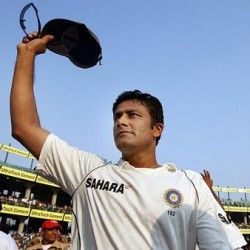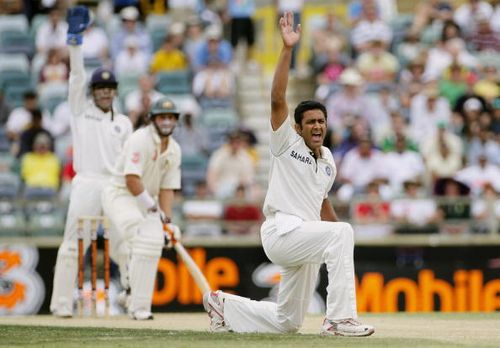
Anil Kumble: The biggest match winner in India’s Test cricket history

Anil Kumble
Anil Kumble was the backbone of India’s bowling for a good part of two decades, the 1990s and 2000s. When he entered the Test arena in the early 1990s, Indian Test cricket lacked a match winning bowler. India’s record in Test cricket in the 1980s was pretty average-of the 26 Test series played in the 1980s, India won only four, while losing 10.
All this changed in the early 1990s with the arrival of a bespectacled leg spinner who bowled almost medium-fast. Kumble set the stage alight with his performances on Indian soil and bowled India to many Test victories in the 1990s. India remained undefeated on home soil in the 1990s, winning 17 Test matches and losing only five.
In 1999, Kumble became only the second bowler in Test history to take all 10 wickets in an innings. He achieved this feat against a strong Pakistan batting line-up which included the likes of Saeed Anwar, Inzmamul Haq and Salim Malik. Wisden rated his performance as the second greatest Test bowling performance of all time.
The slowness of Indian surfaces never troubled Kumble as he bowled at a fast pace and got maximum possible purchase out of the Indian tracks. Even Shane Warne and Muttaih Muralitharan were relatively ineffective on Indian soil. Geoffrey Boycott once said about India’s tall leg-spinner “Kumble in India is simply the best. If I had to face Kumble on Indian soil, the best way to do that would be from the non-striker’s end”.
Kumble’s biggest strengths were his high arm action, steepling bounce and his accuracy. His deliveries burst like packets of water on the slightest hint of a crack. He was a master of line and length bowling, quite similar to Glenn McGrath in that regard. Both relied on creating pressure by bowling stifling lines and choking the batsmen into errors. It wasn’t magical to the eyes like that of Warne or Wasim Akram, but equally effective.
Kumble’s bowling preyed upon any weaknesses in batsmen’s techniques or mindset. In Ian Chappel’s words, “Kumble was like a shark in water. Any weaknesses were like blood which made him smell it and attack like a predator.”
Kumble was especially effective on weary pitches. One of the biggest challenges in contemporary Test cricket was handling Kumble on a wearing track. And most surfaces are naturally weary on the fourth and fifth days. His pace made it very difficult to leave the crease and attack him. So, facing Kumble was always a tough task on most pitches.
His contribution to India’s Test victories can be gauged from his record in Test matches won for India. In 43 Tests that India won with Kumble in the side, he took 288 wickets at an average of 18.75. These included 20 5-wicket hauls and five 10-wicket hauls. He single-handedly won India more Test matches than the combined quartet of Bishan Singh Bedi, BS Chandrashekhar, Erapalli Prasanna and S Venkataraghavan did for India.
Detractors point to his relative ineffectiveness on foreign soil. However he never had world class fast bowlers to support him and create pressure from the other end. Even the Indian batting was poor in the 1990s on foreign soil, which made it difficult for Kumble to make an impact. However things changed in the 2000s with a better batting side in Rahul Dravid, Sachin Tendulkar, Virender Sehwag, VVS Laxman and Sourav Ganguly, all in their prime.
Kumble too adapted and introduced more variety in his bowling. His googly also became more effective. During the 2000s, India performed much better on foreign soil too. Kumble played a major role here as well and contributed to series victories in Pakistan, England and West Indies and Test victories in Australia and South Africa. One of his most notable efforts was his haul of 24 wickets in 3 Test matches against Australia in the 2003-04 series. He also took 6-wicket hauls in Pakistan in 2004 and West Indies in 2006 to win India Test matches there.
Kumble is ranked highly by all his peers. Sachin Tendulkar has said that “Anil is undoubtedly India’s biggest match winner in Tests”. Matthew Hayden says “Kumble is up there with Warne and Murali as a spinner”. Shane Warne ranked him as no. 13 on his list of 100 greatest cricketers of his time.
Kumble finished his career as the third-highest wicket-taker of all time with 619 wickets behind Warne and Murli. He also took around 350 ODI wickets, thus totalling around 950 international wickets. He finished his career in 2008 as the most successful Indian bowler and shaped India into a world champion side in Test cricket. Shortly afterwards, India reached the no. 1 spot in Test cricket in 2009, a goal which was set during Kumble’s reign as Test captain in 2007. He will continue to inspire generations of Indian bowlers to win matches for India and lead India to the top echelons of Test cricket.